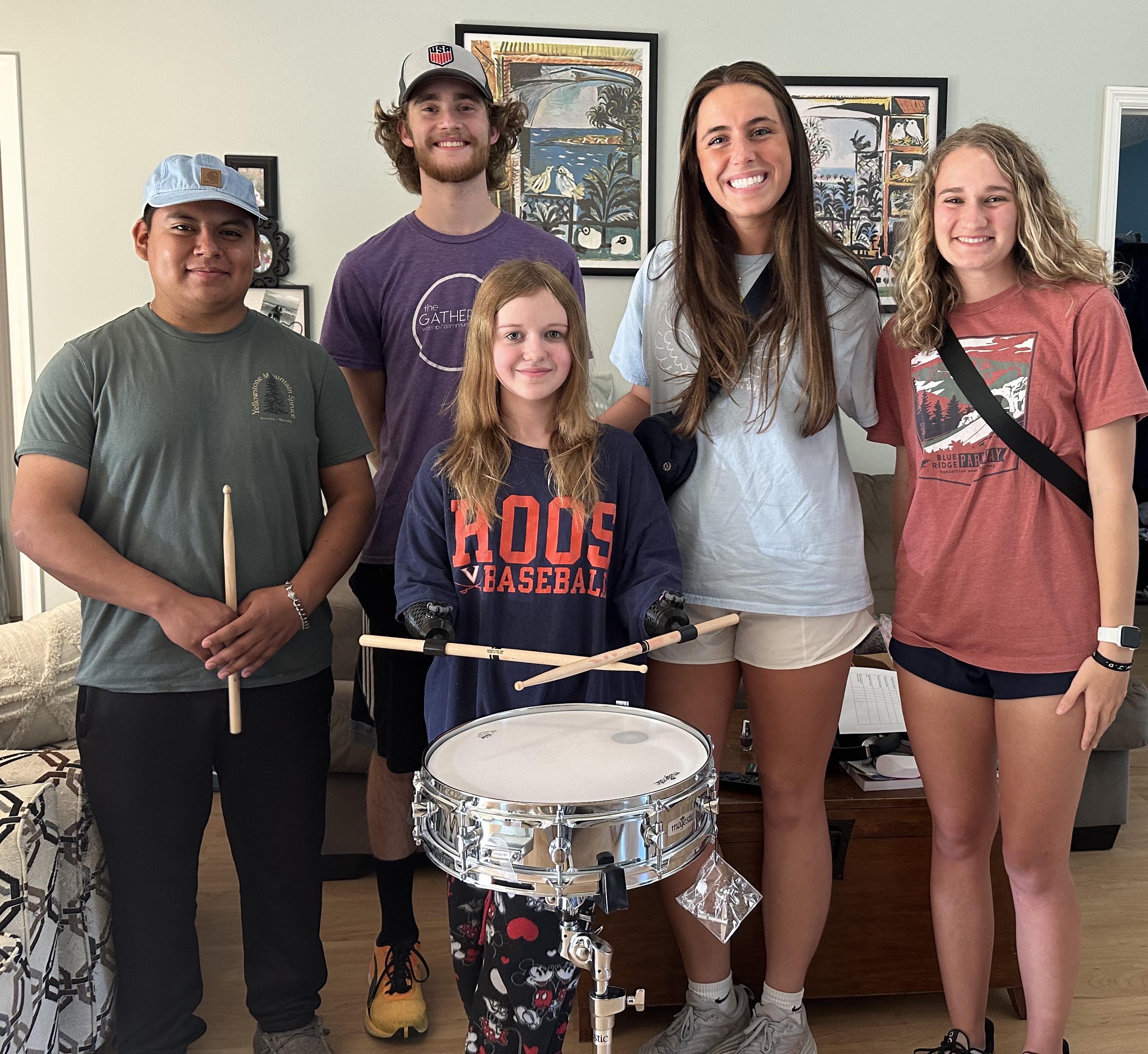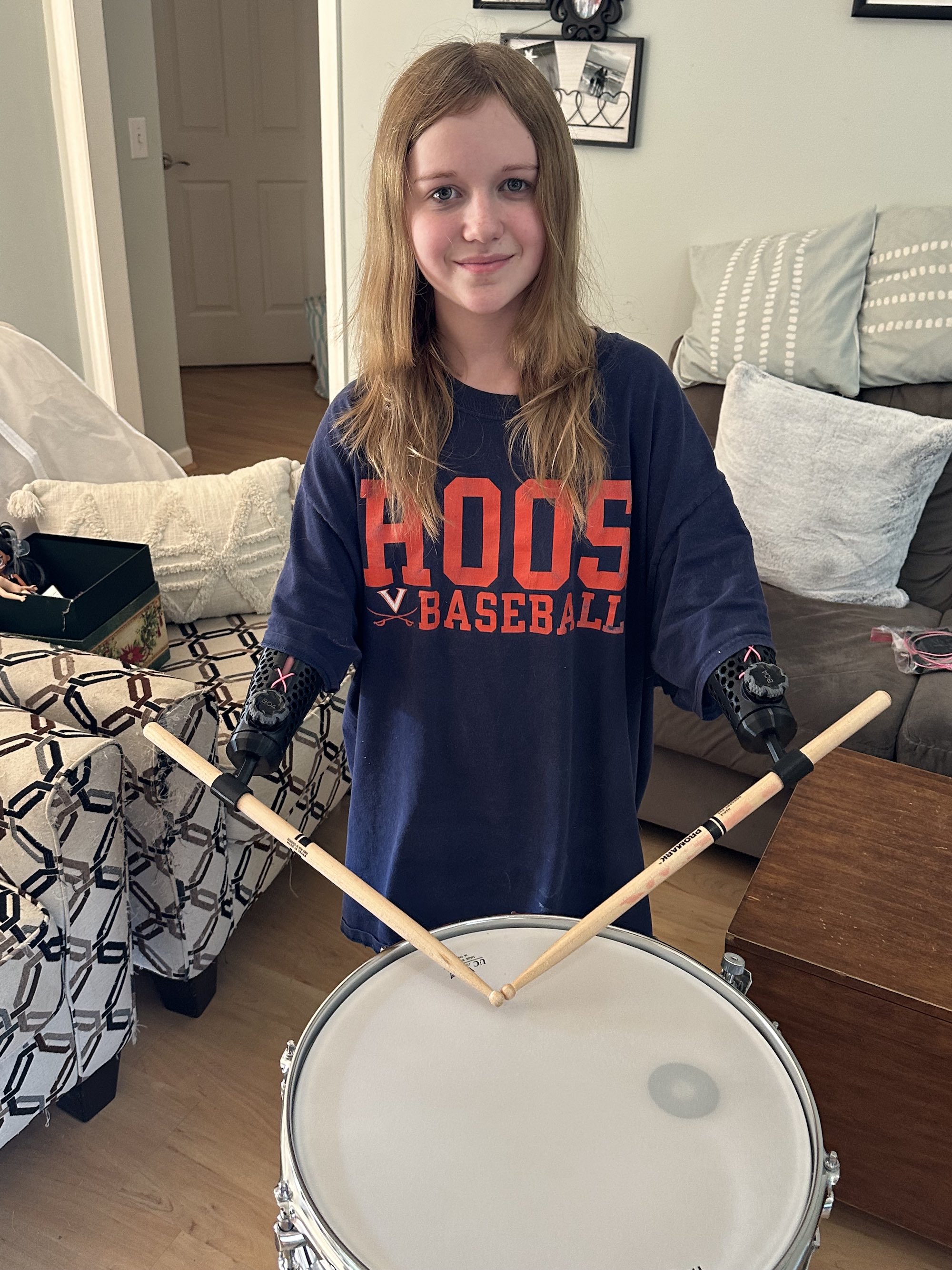Murfreesboro drummer gets prosthetics from Tennessee Tech engineering students

Tennessee Tech engineering students present Aubrey Sauvie, center, new prosthetics
that will help her achieve the same sound quality and volume as other drummers in
her middle school band. The Tech students, from left, are Luis G. Flores-Moreno, Elijah
Sayre, Micah Page and Addie Johnson.
Sometimes in life, we all need a helping hand. That’s what one program at Tennessee
Tech University is all about.
Tech Engineering for Kids (TEK) matches a child with a special need to a team of Tech
engineering students in Stephen Canfield’s Dynamics of Machinery course for mechanical
engineering. This semester, two student teams coordinated efforts to provide prosthetics
to a middle school drummer born without hands.
“When they shared their original design plan with me, I told them they had a one-in-a-million
chance of making it work – but they rose to the challenge and proved me wrong,” Canfield
said. “This ended up becoming a terrific project that we are all excited about.”
This one-in-a-million design means Aubrey Sauvie, who plays the snare drum in her
middle school band in Murfreesboro, can achieve the same sound quality and volume
as the other drummers she plays alongside.
Like everything from writing to brushing her hair, Sauvie has learned to adapt her
own way of doing things – but when it came to her music, she needed a bit of assistance
with the acoustics.
Project team member Andre Braden said, “This is the first time I’ve taken what I’ve
learned in the classroom and truly applied it in a way to impact someone for a lifetime.”
Teammate Luis G. Flores-Moreno agreed, saying, “Doing what we’ve just done really
makes us understand what engineering is about.”
But the team’s cooperation was hard-won. In fact, it was competition that influenced
the two teams to come together in the first place.
“I wanted to work on this project. I’m well versed in 3D printing, and I knew I could
create a high-caliber prosthetic with a level of detail no one else in class could,”
said Branson Blaylock.
When the team he was leading wasn’t selected for the project, Blaylock didn’t take
no for an answer. He and his team approached Canfield and the other team to persuade
them to agree to a merger.
“We all sat down with each other and set our foundation for working together from
day one. The advantage to having two separate teams coming together meant it was much
easier to work in subgroups and distribute specific tasks. We worked as a well-oiled
machine,” said Zak Henson, who became co-leader of the combined group along with Blaylock.
Aubrey Sauvie tries out new prosthetics that enable her to better hold her drumsticks.
The prosthetics were designed by Tennessee Tech engineering students using 3D printing
capabilities.
One subgroup served as a liaison between the project group as a whole and Sauvie and
her family.
“We were able to spend some time with her, observing how she interacts with objects
in her day-to-day life, and we found that she’s so smart, quick-witted and capable
despite not having hands. Her family welcomed us in, and she was such a joy to be
around,” said Addie Johnson, who was on that liaison subgroup.
That’s when the team truly realized they needed to set aside personal desires for
the power of collaboration.
“That’s when we realized that this is and always has been way more important than
just a grade,” Henson said.
Having female engineering students on the liaison subgroup also turned out to be a
significant advantage.
“She opened up to us and wanted to talk about makeup and clothes – you know, things
that many typical pre-teen girls are interested in,” said Micah Page, who served on
the liaison group with Johnson, Flores-Moreno, and Elijah Sayre.
“Without Addie and Micah, we wouldn’t have been able to bond with her as much as we
did. It still would have been a great project, but she just wouldn’t have been able
to open up to me like she did to them. Because of them, we were all able to provide
our best,” said Sayre.
That same feminine touch also came in handy for adding design flourishes. For instance,
the cords for adjusting the tightness of the prosthetics – which are not interchangeable
and are therefore each specifically designed models – are made from bright pink 3D
printing filaments.
As for the designs themselves, everything but the tightening grips is made completely
by 3D printing using a durable, yet flexible material. Their honeycombed pattern makes
them more comfortable for Sauvie to wear in varying temperatures, and the adjustability
means they will still be useful to her as she continues to grow. The drumstick attachments
are made from the same material. They slide snuggly into the holding loops but can
vibrate and reverberate enough to achieve a robust sound when hit against the drum.
“I expected them to 3D print composite casts and use the casts to create the products.
That’s typically how that process works. I didn’t expect them to create almost the
entire products from 3D printing, but they ended up being great working designs,”
Canfield said.
Blaylock said he knew early in the design process that trying to create the prosthetics
from composite casts wouldn’t yield the flexibility the products needed to have.
“The products we created will literally last a lifetime. They can withstand temperatures
up to 540 degrees and as low as -11 degrees Fahrenheit. We performed every stress
test we could think of; we threw them against the wall; we jumped on them. They still
held up,” he said.
What were the group’s overall takeaways?
“Everyone in this group used our own experiences and strengths to contribute to its
overall success,” said team member Michael Cantrell.
“It all came down to relatability and reliability. We had to trust ourselves and each
other, and by doing that, we were able to create something much greater than any one
of us could have achieved alone,” teammate Zac Fisher added.
Some group members also said they hope to continue working with Sauvie on future engineering
projects, creating different attachments that can help her more easily perform other
tasks with the prosthetics.

